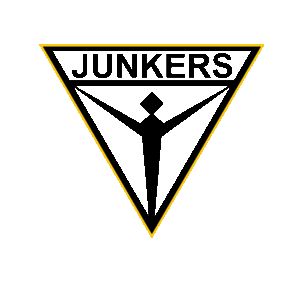
The Junkers Ju 86 was a German monoplane bomber designed in the early 1930s and employed by various air forces on both sides during World War II.
In 1934, a specification for a modern twin-engined aircraft, capable of operating both as a high-speed airliner for the German airline Luft Hansa and as a medium bomber for the nascent Luftwaffe, was issued to both Junkers and Heinkel.
Five prototypes were ordered from each company: the Junkers Ju 86 and Heinkel He 111.
Junkers’ design was a low-winged twin-engined monoplane, of all-metal stressed skin construction.
Unlike most of Junkers’ previous designs, it discarded the typical corrugated skinning in favour of smooth metal skinning which helped to reduce drag.
The craft was fitted with a narrow track retractable-main gear conventional undercarriage with a fixed tailwheel, and twin fins and rudders.
It was intended to be powered by Junkers Jumo 205 diesel engines, which although heavy, gave better fuel consumption than conventional petrol engines.
The design featured the distinctive Junkers doppelflügel control surfaces on the wing, similar to those on the Junkers Ju 52.
These were hinged below the wing’s trailing edge, with the outboard section on each side functioning as an aileron, and the inner section functioning as a wing flap.
The bomber aircraft had a crew of four; a pilot, navigator, radio operator/bombardier and gunner.
Defensive armament consisted of three machine guns, situated at the nose; at a dorsal position; and within a retractable ventral position.
Bombs were carried vertically in four fuselage cells behind the cockpit.
The airliner version replaced the bomb cells with seating for ten passengers, with fuel tanks being moved from the fuselage to the wings.
Jumo 205s were unavailable when the first prototype airframe was completed.
Instead, the bomber-configured Ju 86ab1 was fitted with Siemens SAM 22 radial engines and flew for the first time on 4 November 1934.
The second prototype, also a bomber, flew in January 1935.
The third Ju 86, the first civil prototype, flew on 4 April 1935.
Production of pre-series military and civil aircraft started in late 1935, with full production of the Ju 86A-1 bomber commencing in April 1936.
Production quickly switched to the improved Ju 86D with a modified tail cone to improve stability.
Early use of the Jumo-powered Ju 86 bomber in the Spanish Civil War showed that it was inferior to the He 111, with the diesel engines being unsuitable for rough treatment during combat; and production plans were cut back.
One Ju 86 had already been converted to use radial engines as a testbed for possible export versions, and this showed improved reliability. Production switched to a version powered by the BMW 132 engine, the Ju 86E, with production continuing until 1938.
The Ju 86K was an export model, also built under license in Sweden by Saab as the B 3 with (905 hp) Bristol Mercury XIX radial engines.
Several aircraft remained in service with the Swedish Air Force until 1958.
A few were converted for radio interception activities.
Variants
Ju 86abl
First bomber prototype.
Ju 86bal
Second transport prototype.
Ju 86cb
Third bomber prototype.
Ju 86V5
Prototype for the Ju 86A bomber aircraft.
Ju 86A-0
13 pre-production bomber aircraft.
Ju 86A-1
Initial bomber version.
Ju 86B-0
Seven pre-production transport aircraft.
Ju 86D-1
Bomber version.
Ju 86E-1
Bomber version for the Luftwaffe, powered by two BMW 132F radial engines.
Ju 86E-2
Powered by two BMW 132N radials.
Ju 86G-1
Fitted with a round glass nose.
Ju 86E-2
Uprated version of the Ju 86E-1.
Ju 86K-1
Export version for South Africa and Sweden.
Ju 86K-2
Export version for Hungary.
Ju 86K-4
Export version for Sweden, similar to the Ju 86K-1, but fitted with two Bristol Pegasus III radials.
Ju 86K-5
Swedish-built bomber aircraft, powered by two Swedish-built Bristol Pegasus XII radials.
Ju 86K-6
Export version for Chile and Portugal.
Ju 86K-7
Export version for Austria with BMW 132 radials.
Ju 86K-13
Swedish-built bomber aircraft, fitted with Swedish or Polish-built Pegasus engines.
Ju 86P-1
High-altitude bomber version, fitted with two Jumo 207 diesel engines and with turbochargers.
Ju 86P-2
High-altitude photo reconnaissance version, still equipped for bombing.
Same engines as P-1.
Ju 86R-1
High-altitude photo reconnaissance version.
Retained Jumo 207 engines.
Ju 86R-2
High-altitude bomber version.
Ju 86R-3
Powered by two Jumo 208 engines.
Specifications
Crew
2
Length
16.46 m (54 ft 0 in)
Wingspan
32 m (105 ft 0 in)
Height
4.08 m (13 ft 5 in)
Wing area
97.06 m2 (1,044.7 sq ft)
Empty weight
6,780 kg (14,947 lb)
Max take-off weight
11,530 kg (25,419 lb)
Fuel capacity
1,937 l (512 US gal; 426 imp gal)
Powerplant
2 × Junkers Jumo 207B-3,
6-cylinder liquid-cooled 2-stroke opposed-piston diesel engines,
750 kW (1,000 hp) each for take-off
560 kW (750 hp) at 12,000 m (40,000 ft) with GM-1 Nitrous Oxide injection
Propellers
4-bladed constant-speed propellers
Performance
Maximum speed
420 km/h (260 mph, 230 kn) at 9,000 m (30,000 ft)
370 km/h (230 mph; 200 kn) at 9,000 m (30,000 ft)
Cruise speed
250 km/h (160 mph, 130 kn) at 13,700 m (44,900 ft)
Range
1,750 km (1,090 mi, 940 nmi)
Endurance
7 hours 10 minutes
Service ceiling
14,400 m (47,200 ft).


